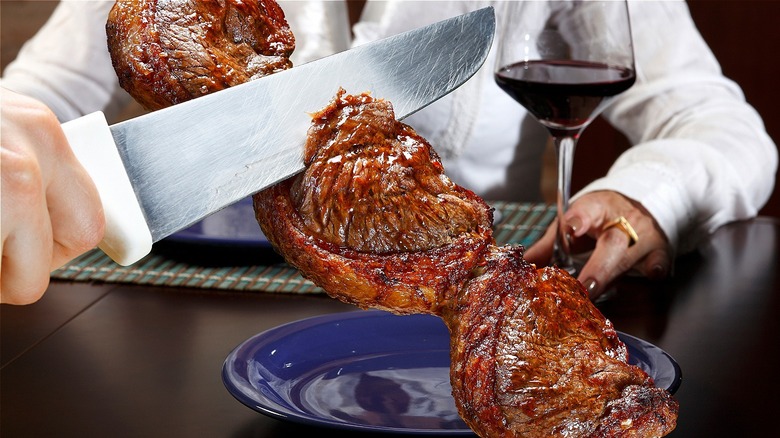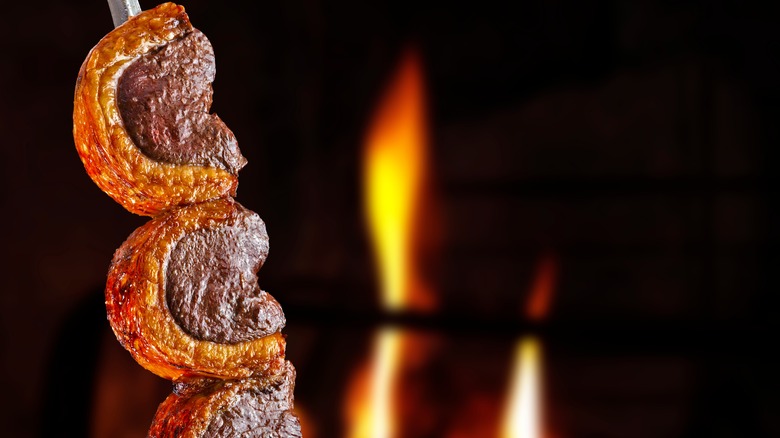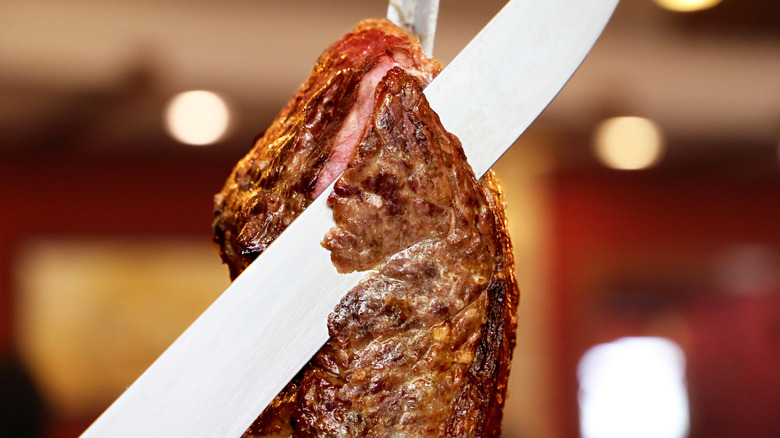We Finally Know Why Brazilian Steakhouses Are So Expensive
In the U.S., going to a Brazilian steakhouse is a special-occasion that demands setting aside both a good chunk of money and a few hours (if not a full day) to digest. With its well-dressed waiters and opulent decor, Fogo de Chão seems to be a storied carnivore's paradise. However, the franchise, which brought Brazilian barbecue worldwide, is actually relatively new to the fine dining scene — both globally and in Brazil.
Before Fogo de Chão landed in Dallas in the late '90s, Americans had just started to get used to all-you-can-eat buffets of the Golden Corral variety. They had yet to see a luxury steakhouse that brought an endless buffet to them in the form of premium cuts of beef. In Brazil, a fancy Churrascaria (steakhouse) will probably run you between $15 – 20, which is expensive by the country's standards. In the U.S. you can expect to pay upwards of $70 per person for the all-you-can-eat experience at an upscale Brazilian steakhouse. But why exactly are these restaurants so pricey?
Firstly, they aren't bad compared to other meat-heavy options. Upscale American chain Ruth's Chris charges $69 for a ribeye. So, Fogo de Chão's $75 all-you-can-eat meat — plus a salad and feijoada (Brazilian stew) bar — doesn't seem too shabby. Some smaller chains even charge less than $40 for the experience. Also, many restaurants will adjust pricing for children to accommodate smaller appetites. Secondly, you're paying for an experience — what Fogo de Chão describes as the "rich heritage" of churrasco (Brazilian barbecue). You get an all-you-can-eat, diverse selection of meats that comes right to your table. They are sourced from high-quality suppliers, aged, and perfectly cooked.
From humble beginnings to fine dining
Fogo de Chão's name literally translates to "fire in the ground" or "fire pit." This references the restaurant's humble origins in a wooden farmhouse in Brazil's southernmost state. Rio Grande do Sul is the heart of the country's cattle-herding gaúcho (South American cowboy) culture and the birthplace of churrasco, which traditionally used a fire pit.
The franchise's expansion to Brazilian cities helped elevate rodízio (or literally, "rotation") dining to a point of national culinary pride in the 1980s and '90s. The model of obliging waiters bent on filling your belly started with meat, but was adapted for all-varieties of cuisines from Japanese food to pizza and dessert. The national favorite remains the steakhouse version, with picanha (sirloin cap) being the most precious commodity. The exceptionally tender cut of meat is capped with a flavorful layer of fat that, if cooked to perfection, melts in your mouth.
It's no coincidence that the first Fogo de Chão in the U.S. opened in the Lone Star State, as Rio Grande do Sul, for all its cool hats and meat-loving, is considered the Texas of Brazil (it also continues to tease secession). Naturally, the model was a hit, and Fogo de Chão grew to nearly 60 locations in the US, more than they operate anywhere else, including Brazil. Now, it remains a premium example of how a dining experience can blend culture and food.
Brazilian steakhouses provide an endless buffet of premium options
Yes, they're expensive, but in return, rodizios like Fogo de Chão offer a pretty unbeatable selection. Some Brazilian steakhouse meats are better tried than explained, but it's still good to walk into the restaurant knowing what to expect.
There's fraldinha, known as flank or skirt steak in the U.S., which is tougher than other cuts but tastes wonderful when perfectly cooked and sliced thin. Less common at U.S. rodizios are maminha (a tri-tip or bottom sirloin) and alcatra (top sirloin), though both are flavorful cuts. There's also costela, ribs you can gnaw right off the bone, and more recognizable cuts like ribeye (often called bife ancho) and filet mignon. And, of course, don't forget the tender and juicy star of the show — picanha.
To relieve red-meat fatigue, rodizio's usually offer an array of non-beef options like linguiça (sausage), pernil (slow-roasted pork shoulder), cordeiro (lamb), and various cuts of chicken, including chicken heart. While meat is the focus at Brazilian steakhouses, it's not the only reason people pay an arm and a leg for all-you-can-eat food.
Other staples at these restaurants include the country's beloved pão de queijo (Brazilian cheese bread), pão de alho (Brazilian garlic bread), tapioca and yucca fries, fried bananas, and grilled Pineapple, which is usually seasoned with cinnamon. There's also a wide selection of garnishes and sauces to complement your meat. Don't forget the chimichurri!


